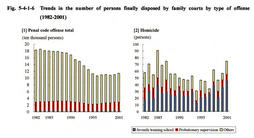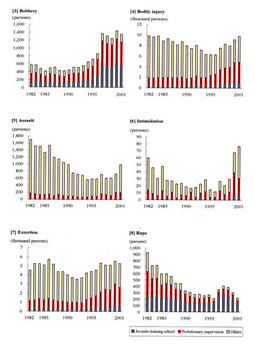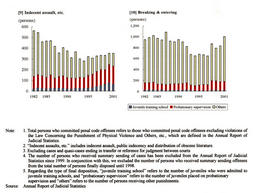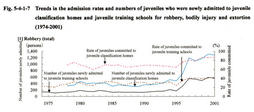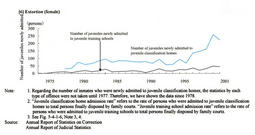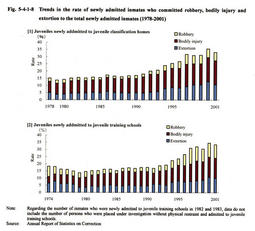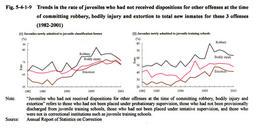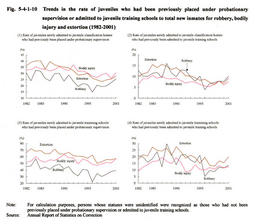| Previous Next Index Image Index Year Selection | |
|
|
2 Trends in juvenile correction (1) Number of persons finally disposed by family courts Fig. 5-4-1-6 shows the trends in the number of persons finally disposed by family courts for homicide and the 9 types of violent offenses, with the exception of destruction of objects. The number of persons referred to juvenile training schools has increased for homicide, robbery, bodily injury, extortion and indecent assault from 1982 to 2001. However, overall, it has not experienced remarkable change other than a decrease in rape. In terms of indexing taking the figure for 1982 as 100, the number of persons referred to juvenile training schools in 2001 was greatest for robbery (numbering 414), followed by bodily injury (279), indecent assault (268), and homicide (256).
(2) Juvenile correctional institutions Fig. 5-4-1-7 shows the trends in the number of persons who were newly admitted to juvenile classification homes and juvenile training schools for robbery, bodily injury and extortion. Fig. 5-4-1-8 shows the trends in the rate of new juvenile inmates who committed robbery, bodily injury and extortion to total new juvenile inmates.
The number of juvenile inmates who were newly admitted to juvenile classification homes and juvenile training schools for robbery, bodily injury and extortion has increased rapidly since around 1996. Consequently, it can be considered that the recent increase in juvenile inmates who were admitted to these institutions was mainly caused by the increase in these 3 offenses. According to Fig. 5-4-1-9 and Fig. 5-4-1-10 , in terms of the personal status of juveniles who committed robbery, bodily injury and extortion, the rate of juveniles who had not received a certain disposition such as probationary supervision at the time of the offense has been on the rise in the long term, and the rate of juveniles who had not been previously admitted to juvenile training schools nor placed under probationary supervision has been also rising. Fig. 5-4-1-6 Trends in the number of persons finally disposed by family courts by type of offense (1982-2001) Fig. 5-4-1-7 Trends in the admission rates and numbers of juveniles who were newly admitted to juvenile classification homes and juvenile training schools for robbery, bodily injury and extortion (1974-2001) Fig. 5-4-1-8 Trends in the rate of newly admitted inmates who committed robbery, bodily injury and extortion to the total newly admitted inmates (1978-2001) Fig. 5-4-1-9 Trends in the rate of juveniles who had not received dispositions for other offenses at the time of committing robbery, bodily injury and extortion to total new inmates for these 3 offenses (1982-2001) Fig. 5-4-1-10 Trends in the rate of juveniles who had been previously placed under probationary supervision or admitted to juvenile training schools to total new inmates for robbery, bodily injury and extortion (1982-2001) |
